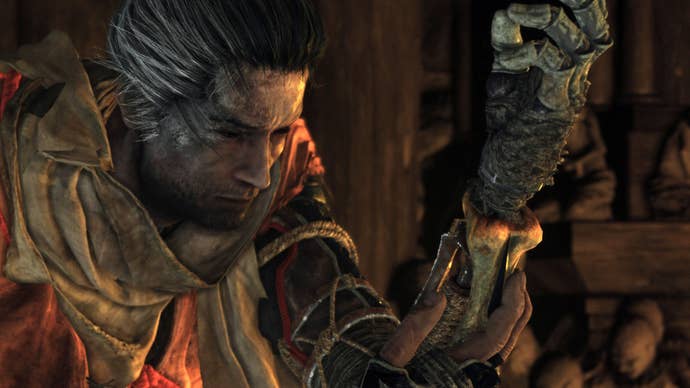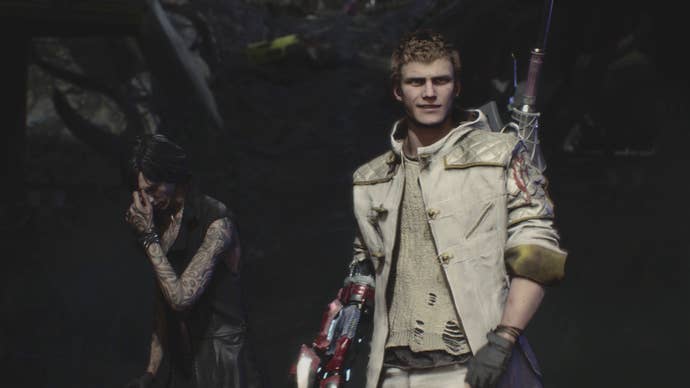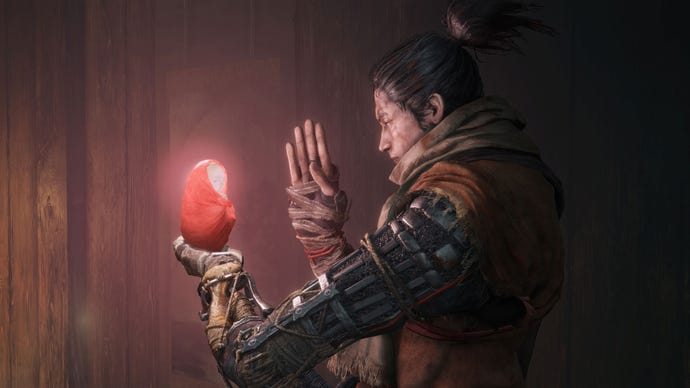How Sekiro: Shadows Die Twice and Devil May Cry 5 Are Empowering For Those Who Live With Prosthetics
The gamified prosthetics in Devil May Cry 5 and Sekiro: Shadows Die Twice are actually closer to reality than one might think.
This article first appeared on USgamer, a partner publication of VG247. Some content, such as this article, has been migrated to VG247 for posterity after USgamer's closure - but it has not been edited or further vetted by the VG247 team.
With a great deal of deaths at the hands of Sekiro: Shadows Die Twice's General Naomori Kawarada under his belt, John Mangum realized he needed to approach the samurai in an unconventional way. He zipped from rooftop to rooftop with his Shinobi prosthetic grappling hook until he was high above Kawarada's head, like a bird of prey approaching its next victim. He dove down and drove his sword straight through his back—circumventing half the battle just like that.
Unfortunately for him, Kawarada had two health bars. But Mangum had realized in that moment that the Shinobi prosthetic could be used in creative ways to help him in combat. "After a few pointless sword swipes, I grappled to another high point and did another jumping attack, which failed," he tells me. "I beat him eventually, but I doubt that I would have come up with that stealth strategy if I hadn't thought of using the prosthetic in an unconventional way. I relate to the idea of thinking that way as I am a one legged person."
Mangum, who lost his leg due to an infection and buildup of abscess in his foot in 2015, found Sekiro's portrayal of prosthetic limbs to be empowering. "Usually, an amputee character is nothing more than a skin and we don't really see it have many effects. Rarely are phantom pains or the other aspects of it explored," he says. "The over-the-top feeling of Sekiro's prosthetics really helps me enjoy being an amputee with these amazing abilities. It isn't a feeling that I usually associate with prosthetics."

You'd think losing an arm would hinder a warrior's ability to fight enemies, but that isn't the case for Nero and The Wolf, the main characters of Devil May Cry 5 and Sekiro: Shadows Die Twice respectively. Instead it opens up a new world of possibilities as they gain near-supernatural prosthetics after losing their arms in combat. Their new limbs possess the ability to unfold into three layers of sharp, twisted metal that can grind through enemies, throw bursts of fire into the faces of ogres, and grant dozens of other abilities that weren't possible before.
"As an amputee, it's cool to think that I could have the ability to do that. It sets me apart," says amputee activist and actress Angel Giuffria. "I'd go down the list and there isn't an arm in Sekiro or Devil May Cry that I wouldn't want. It gives me the option to do something that others don't have, which is something that you don't hear a lot as a person with a disability."
While the portrayal of prosthetic abilities in both games might be dramatic (it'll probably be a long time until we can zip from building to building with a grapple like The Wolf does), the depiction isn't terribly far from the truth.
"A lot of prosthetic technology is used in research to provide active duty soldiers super capabilities. It won't be the same as it is in these games, but weaponizing it isn't that hard," says Arun Jayaraman, PT, PhD, a research scientist at Shirley Ryan AbilityLab and associate professor at Northwestern University. "A lot of this stuff we're doing wasn't possible five, ten years ago—the batteries and attachments weren't there yet. Everything is getting smaller though, so who knows what could be possible in another ten years."
Synthetic Shinobi
Sekiro's depiction of prosthetics are incredibly down to earth. The Wolf, a Shinobi of the game's re-imagined 16th century Sengoku period, loses his arm early on during a fight. He gains a special prosthetic arm from a statue carver that saves him from dying after the battle. "It was really important that they show how they lost their arm," Giuffria says. "I didn't lose mine, I was born without it. But a lot of other amputees like to see the entire story, the progression of the character. It shows that they are human."

Nothing about the prosthetics in Sekiro are too farfetched, although it's doubtful the type of technology required to create this weapon would have existed in the 16th century. Throughout the game, The Wolf gains a variety of simplistic tool attachments he can use with his prosthetic, including firecrackers, an axe, a shield, and others. The implementation of these tools reflects modern prosthetic technology.
"There has been a universal coupler that lets patients attach different components to their socket in the elbow or sometimes the shoulder. You can add any type of end product at the end of the elbow. You can really do whatever you want," Dr. Jayaraman says. "These ideas might look far fetched in the game and don't work that way in reality," he added. "But they're actually real and in use by those who wear real-world prosthetics."
The Wolf's prosthetic tools are actually quite similar to different attachments that amputees use today. Limbitless Solutions created a specific tool to help a girl learn to play the guitar, a fishing pole that's an actual extension of the arm, and others include hooks and clamps that make working with power tools easier.
"I have my daily wear hand that I use throughout the day, then I have different attachments. I have ones for different activities, like archery," Giuffria says. "I'm not sure if it was intentional, but Sekiro does kind of reflect how my daily life consists of carrying around a bag of these different attachments."
Breakers and Bionics
Nero's Devil Breakers, multiple devices that replace his lost arm after it got ripped off by a mysterious foe, give him a dozen (if you include the different DLC breakers) abilities, including everything from stopping time to drawing out a giant chain whip. While freezing enemies in time isn't possible in the real world just yet, many of Nero's other breaker abilities are just incredibly exaggerated versions of things that prosthetics could be used for.
Take the Buster Arm, for example; it makes Nero's punches so powerful that they can toss building-sized demons high into the sky. "It's a possibility in real bionic limbs. You're just over-activating the arm, a wound up punch," Dr. Jayaraman says. "They're sensitive enough to lift a grape but they are also strong enough to punch through a wall."

The Overture and Gerbera, which use electric bursts and shockwaves to hurt enemies, is another possibility that isn't far fetched. While real-world prosthetics may not grant amputees the ability to dash with instantaneous speed, the electrical shock has real-world implications in combat.
"These arms are battery powered, and the ones we work with usually have a ten-hour battery life before needing to recharge," says University of Central Florida assistant professor of game design Peter Smith. Smith also works with Limbitless Solutions, a non-profit focused on creating affordable and accessible prosthetics. "A shock or surge is a real possibility, but something like that would depower the arm quite quickly."
Nero's other abilities (including Rawhide, that turns the breaker into a chain whip, and Helter Skelter, that draws out several rotating blades) are also in the realm of possibility—except, if made in real life, they'd just be scaled back versions of what we see in the game. Unfortunately, Ragtime's ability to stop time is still out of reach.
Outside the actual abilities they feature, both games show their amputee characters without their prosthetics. Nero is shown without his arm whenever all of his Devil Breakers are used up (they are destroyed once he uses their main ability) and The Wolf is shown without his arm before the stature carver gives him the Shinobi prosthetic.
"Just walking around with Nero without his breaker is special because it shows that he still exists this way," Giuffria says. "You're still you, whoever you were before, even if you have this tool with amazing abilities."
These portrayals of prosthetics, including how they work, how each character lost their limb, and showing Nero and The Wolf fighting without them helps players view these synthetic limbs and the people who use them in a positive light—something that popular media hasn't done well in the past. It adds two powerful heroes to a short list characters, including ones like Symmetra from Overwatch and Hiccup from How to Train Your Dragon, that show the possibilities that prosthetics provide.
It also works as a great way to fuel interest in prosthetic technology so that we can move closer to making some of these gamified abilities that aren't possible yet, as crazy as they might be, a reality.
"The more often games show arms doing cool stuff like this, the more often people are going to ask 'why don't they?' in real life," Giuffria says. "If the only people interested in developing prosthetics are the people affected by them, we wouldn't be nearly as far along as we are now. These games are stoking the interest of the people who can actually make a difference. The representation comes out in a positive way, no matter what, with that in mind. It's worth it if it can inspire anyone to help."
If you enjoy reading about great video games, you'll find a neat collection of more in our ever-growing list of the best games of 2019. It's easy to lose track of new releases, so use this list to make sure you don't miss the games we think are essential.

